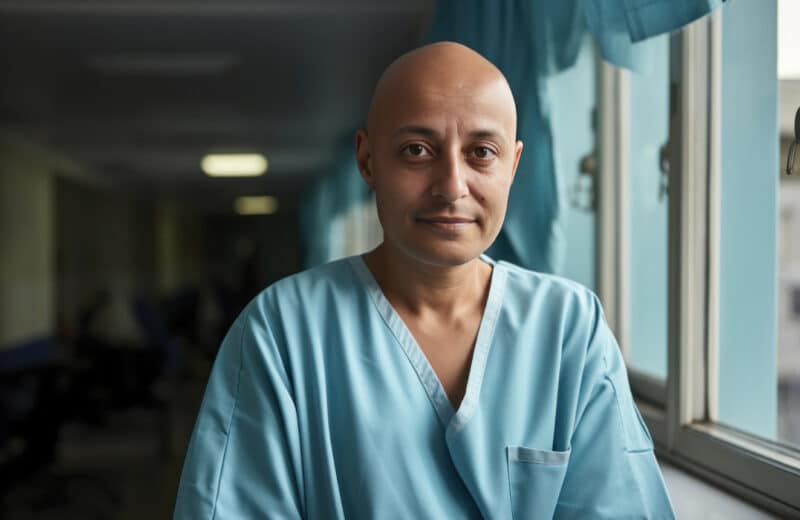Alexis Gabay was about to meet the radiation therapist who would be with her during her four weeks of breast cancer treatment at Northwestern Memorial Hospital. It was 7:30 a.m. and she sat waiting for her name to be called.
Feeling uneasy, Gabay approached the nurse’s station. “This is my first day of treatment, and I don’t know what to do,” recalls Gabay, a 59-year-old Chicago attorney. “A woman from the radiation staff approached and provided me with the information I would need. Her kindness and words of encouragement immediately put me at ease.”
What could have been a stressful month, lying in a robe on a raised bed with a machine whirring around her, changed. Gabay was comforted by the demeanor of the radiation therapists tending to her. They greeted her warmly. “How was your weekend?” “Are you working today?” they asked. “Only six more days of treatment.”
They were gentle and caring, checking to see if she was okay. “It felt like Team Alexis. It made the entire experience less upsetting,” Gabay recalls.
Helping to lessen fears
Compassionate care is becoming more important than ever. In medical schools, students are shown the human element of medicine and taught how to alleviate fears and give emotional support to patients during treatment. That’s because evaluating a patient’s wellbeing, noticing their reactions and anxieties and using encouraging words can go a long way to enhance the patient’s overall experience.
“What I do for my patient-care classes is incorporate soft skills into the program,” says Pamela Harmon, Triton College teacher and radiology program coordinator. “I was getting feedback from clinical sites that students often had difficulty conversing with the patients, such as making small talk and maintaining eye contact.”
Harmon advises her students to be observant. “I tell them that when a patient shows up and you see they have a baseball cap on, you can say, ‘Oh, you must be a big fan of (that team).’ I encourage them to look into the person’s eyes and notice if they seem stressed or depressed. Are they in pain? Have they been crying?”
“Listening skills are important,” she says. “When the patient leaves, knowing their technologist acknowledged their concerns, they will feel validated.”
To teach medical students compassion, Harmon has her students walk blindfolded across campus, guided by a fellow student playing the part of the technologist. The person who can’t see has to fumble up hills and down steps unsure and anxious — similar to how a patient feels before undergoing radiology treatment, she says.
Building trust
Medical technologists play a key role in working with patients. They need proficiency in various technological areas, such as machinery, computers and electronics. They are skilled in patient positioning and taking safety precautions if working with radiation. Communication and compassion are essential too.
At Rush University Medical Center, in-patient MRI manager Brian Jarrett believes in building trust before starting with a patient. “The worst time to find out that you are claustrophobic is inside an MRI machine,” he says.
Jarrett looks at a patient’s body language from the time they enter the door and assesses if they are anxious. “I’m claustrophobic myself. I know what it is like to be inside the tight space of an MRI machine,” Jarrett says. “In those situations, I will have them get on the table and do a test run. I will show them how far they will be going in. Then, I will pull them out. I will work with the patient, helping them get through it.”
“Instead of telling patients, ‘You have 25 minutes left,’ I will say, ‘You have five scans left.’ I redirect them to the smaller number, instead of the bigger one.”
A personal connection
“Human connection is so important,” says Luis Marquez, system director of imaging and cardiology at Sinai Health System. “Every patient who comes through our door is treated with respect and dignity.” In many healthcare organizations, patient advocates or caregivers provide a personal connection and offer comfort.
“When [patients] come to our department, our caregivers and technologists will introduce themselves,” Marquez says. “They will speak with the patient about what to expect from start to finish. This is critical because it reduces the anxiety the patient may come in with.”
For some patients, the compassionate care aspect is secondary. They would prefer the technologist focus on the scans and the equipment first. After that, compassion becomes important to them.
“For me, competency is the most important factor when undergoing a procedure,” says Chicago resident Barbara Friedman, who has gone through a number of MRIs over the years. “Of course, a gentle, caring and supportive staff is always welcome and enhances the experience.”
Most would agree that clinical excellence accompanied by a dose of compassionate care is the winning combination.
“Accurate testing is essential, but having the skills to be able to communicate effectively and appropriately is important,” Marquez says.
Jarrett is a firm believer in personalizing the patient’s experience, becoming a partner in their care.
“From a technologist’s perspective we are there with the patients. Whether it be their technician, coach or cheerleader, it is a partnership. We are doing this journey together.”












